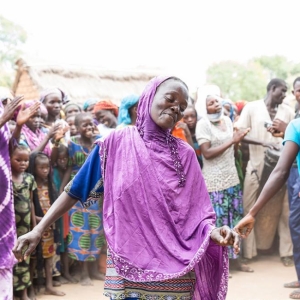En 2015, la Organización Internacional para las Migraciones (OIM) desarrolló un Marco de Gobernanza de la Migración (MiGOF) para ayudar a los Estados a definir los elementos esenciales que constituyen la base necesaria para una “política de migración bien gestionada” a nivel nacional. El MiGOF fue bien recibido por los Estados Miembros de la OIM el mismo año. Los Indicadores de Gobernanza de la Migración (IGM) han sido desarrollados para operacionalizar el MiGOF a través de cerca de noventa indicadores agrupados en seis dimensiones claves de políticas públicas.
Haga clic en la rueda para obtener más información sobre las seis dimensiones de la gobernanza de la migración incluidas en el MiGOF y los IGM.
Los IGM son una herramienta basada en el análisis de las estructuras de la gobernanza migratoria que presenta una serie de pautas sobre los instrumentos que el Estado podría usar para desarrollar su gobernanza. Los IGM evalúan únicamente el marco institucional, jurídico y de políticas públicas en materia de migración, sin entrar a evaluar su implementación en la práctica. Los IGM funcionan como un marco de referencia que permite identificar medidas que los países podrían adoptar para fortalecer sus estructuras de gobernanza de la migración. El objetivo de los IGM es contribuir a la conversación sobre la gobernanza migratoria definiendo lo que podría ser una “política migratoria bien gestionada” en el contexto de la meta 10.7 de los Objetivos de Desarrollo Sostenible (ODS).
Para obtener más información sobre el proceso de los IGM, haga clic aquí
Los indicadores de este dominio analizan los derechos de los migrantes a los servicios sociales básicos, como la salud, la educación y la seguridad social. Estos también presentan los derechos de los migrantes a la reunificación familiar, al trabajo, a la residencia y a la ciudadanía. La ratificación de las principales convenciones internacionales también se incluye dentro de este dominio.
Los indicadores de esta categoría se utilizan para definir la medida en que las personas migrantes tienen acceso a determinados servicios sociales, como la salud, la educación y la seguridad social. También remiten a las medidas adoptadas para garantizar la integración y el acceso al empleo.
Los indicadores en este dominio evalúan los marcos institucionales, legales y regulatorios de los países relacionados con las políticas migratorias. También revisan la existencia de estrategias nacionales de migración que están en línea con el desarrollo, así como la transparencia institucional y la coherencia en relación con la gestión de la migración. Este dominio investiga en qué medida los gobiernos recopilan y usan los datos de migración.
Los indicadores de esta categoría sirven para evaluar los marcos institucionales de autoridades locales o estados en lo referente a la migración. También permiten determinar la existencia de estrategias migratorias que sean acordes a los objetivos de desarrollo, así como la transparencia y coherencia institucional en relación con la gestión de la migración.
Este dominio se enfoca en los esfuerzos de los países para cooperar con otros Estados y con actores no gubernamentales (incluyendo organizaciones de la sociedad civil y el sector privado) en asuntos relacionados con la migración. La cooperación puede conducir a mejoras en la gobernanza al alinear y elevar los estándares, aumentar el diálogo y proporcionar estructuras para superar desafíos.
Los indicadores de esta categoría se centran en las medidas adoptadas por autoridades locales o estados para cooperar con los gobiernos nacionales en torno a cuestiones migratorias, así como con otros agentes no gubernamentales pertinentes, como las organizaciones de la sociedad civil y el sector privado.
Este dominio incluye indicadores sobre las políticas de los países para gestionar el bienestar socioeconómico de los migrantes, a través de aspectos como el reconocimiento de las calificaciones educativas y profesionales de los migrantes, las disposiciones que regulan la migración estudiantil y la existencia de acuerdos laborales bilaterales entre países. Los indicadores se centran igualmente en las políticas y estrategias relacionadas con el compromiso de la diáspora y las remesas de los migrantes.
Los indicadores de esta categoría permiten evaluar las iniciativas de autoridades locales o estados en lo relativo a la movilidad de estudiantes internacionales, el acceso al mercado laboral y las condiciones de trabajo decente para los trabajadores migrantes. Los aspectos relativos a la participación de las diásporas y las remesas de las personas migrantes también pertenecen a esta esfera.
Este dominio estudia el tipo y el nivel de preparación de los países cuando se enfrentan a crisis de dimensiones de movilidad, vinculadas a desastres, el medio ambiente y/o conflicto. Las preguntas se utilizan para identificar los procesos vigentes para nacionales y no nacionales durante y después de un desastre, incluso si la asistencia humanitaria está igualmente disponible para los migrantes que para los ciudadanos.
Los indicadores de esta categoría se refieren al tipo y nivel de preparación de autoridades locales o estados a la hora de encarar los aspectos relativos a la movilidad en situaciones de crisis. Permiten indagar acerca de los procesos establecidos para las personas nacionales y no nacionales tanto durante como después de desastres, incluso cuando la asistencia humanitaria está disponible en la misma medida tanto para las personas migrantes como para las nacionales del país concernido.
Este dominio analiza el enfoque de los países respecto a la gestión migratoria en términos de control fronterizo y políticas de aplicación, criterios de admisión para migrantes, preparación y resiliencia en caso de flujos migratorios significativos e inesperados, así como la lucha contra la trata de personas y el tráfico ilícito de migrantes. También evalúa los esfuerzos y los incentivos para ayudar a integrar a los ciudadanos que regresan.
Los indicadores de esta categoría sirven para evaluar el enfoque que aplican autoridades locales o estados respecto del acceso de las personas migrantes a políticas de seguridad, retorno y reintegración, así como en lo relativo a la lucha contra la trata de personas.
This country Profile describes examples of well-developed areas of the Republic of Namibia (hereafter referred to as Namibia) migration governance structures and areas with potential for further development, as evaluated through the six domains of the Migration Governance Indicators (MGI). These address migrants’ rights, a “whole-of-government” approach, partnerships, socioeconomic well-being of migrants, the mobility dimensions of crises, and safe and orderly migration.
Click the icons on the wheel to explore the key findings.
The Migration Governance Indicators (MGI) initiative is a policy-benchmarking programme led by the International Organization for Migration (IOM) and implemented with research and analysis from the Economist Intelligence Unit. Funding is provided by IOM Member States.
Migration Governance: examples of well-developed areas
- Migrants with a regular migratory status have the same access as citizens to universal free primary and secondary education.
- Migrants with a regular status can access any private sector job and self-employment.
- All temporary residents can apply for a permanent residence permit in Namibia and there is no requirement for the applicant to have lived in Namibia for a certain length of time.
- There are three pathways to citizenship for migrants under the Namibian Constitution.
Areas with potential for further development
- According to the Hospitals and Health Facilities Act (1994), only citizens or permanent residents can access government-funded healthcare.
- Only citizens and permanent residents have access to social protection.
- Namibia does not have a specific policy or strategy in place to address hate crimes, violence, xenophobia and discrimination against migrants.
Migration Governance: examples of well-developed areas
- The Ministry of Home Affairs, Immigration, Safety and Security developed and is responsible for coordinating implementation of the National Migration Policy (NMP) (2020).
- The NMP, and its implementation action plan (2020), seek to create a well-managed migration process that considers the needs, aspirations, concerns and possible benefits of movement of persons within, to and from Namibia.
- The NMP states the need to enact laws that clearly prescribe affirmative action for vulnerable groups of society, especially during and after migration.
- The Population and Housing Census includes questions on migration.
Areas with potential for further development
- The inter-ministerial National Committee for Migration Management does not meet regularly.
- Namibia has not yet developed a framework to formally include its diaspora in policy considerations.
- Namibia regularly collects administrative migration data, but these are not published.
Migration Governance: examples of well-developed areas
- Namibia is a member of the Pan-African Forum on Migration and also participates in the Migration Dialogue for Southern Africa.
- The country has Joint Permanent Commissions on Defence and Security with three neighbouring countries – Angola, South Africa and Zambia – to discuss defence and security issues, including immigration.
- Namibia engages civil society organizations on migration issues.
Areas with potential for further development
- Namibia engages with the private sector in agenda setting and implementation of migration-related issues only on an ad hoc basis.
- Namibia is not part of any regional agreement promoting labour mobility.
Migration Governance: examples of well-developed areas
- The Immigration Selection Board under the Ministry of Home Affairs, Immigration, Safety and Security grants permits based on whether the applicant has the required skills, qualifications and experience in their specific field.
- The Labour Act No.11 (2007) establishes several measures to protect all workers, including migrants, against exploitation.
- The country has well-defined accreditation criteria to recognize foreign educational and professional qualifications through its National Qualifications Framework.
Areas with potential for further development
- The Namibia Integrated Employment Information System is not utilized to its full capacity for monitoring labour market demand for immigrants, domestic labour supply and the effects of emigrants on the domestic labour market.
- Namibia does not have specialized visa types to attract specific labour skills.
- The country is not actively involved in promoting the creation of formal remittance schemes.
- International students pay higher fees than citizens to access university education.
Migration Governance: examples of well-developed areas
- The National Disaster Risk Management Plan 2011 (NDRMP) makes provisions for ensuring that family ties are protected and family members are traced and reunited if separated during displacement.
- Namibia’s disaster communication systems policy takes into account the needs of all people, including migrants.
- Namibians abroad are able to voluntarily register at embassies or consulates, which provide consular and welfare services (such as repatriation) in cases of emergencies.
Areas with potential for further development
- The NDRMP, National Disaster Risk Management Policy (2009) and National Disaster Management Act (2012) do not contain specific measures to provide assistance to migrants before, during or post-crisis.
- The National Policy on Climate Change for Namibia (2011) does not address climate change-related migration, displacement or relocation.
- There are no specific measures to promote the sustainable reintegration of returning migrants who have fled the country during crises.
Migration Governance: examples of well-developed areas
- Namibia uses the advanced Electronic Border Management System to facilitate border control and monitor visa overstays.
- The Ministry of Home Affairs, Immigration, Safety and Security provides training on immigration laws and regulations for border staff upon recruitment.
- The Combating of Trafficking in Persons Act No.1 (2018) includes provisions to prosecute trafficking offences, prescribes penalties, and provides for the protection of and assistance to victims of trafficking, including child victims.
Areas with potential for further development
- Namibia does not have a specific policy or strategy to ensure that migrant detention is used only as a measure of last resort.
- There is no formal government programme or dedicated policy that focuses on facilitating the reintegration of returning nationals.
- Namibia does not have systems or formal cooperation agreements with other countries to trace and identify missing migrants within the national territory.




